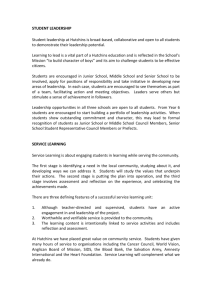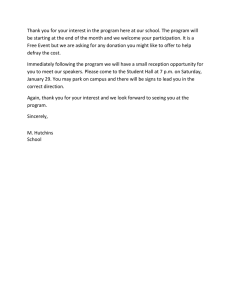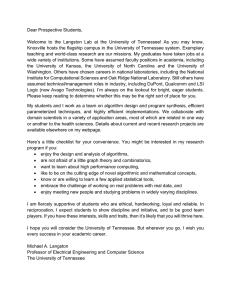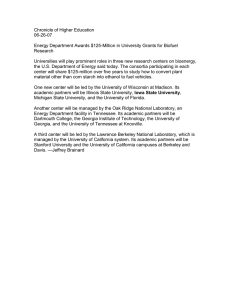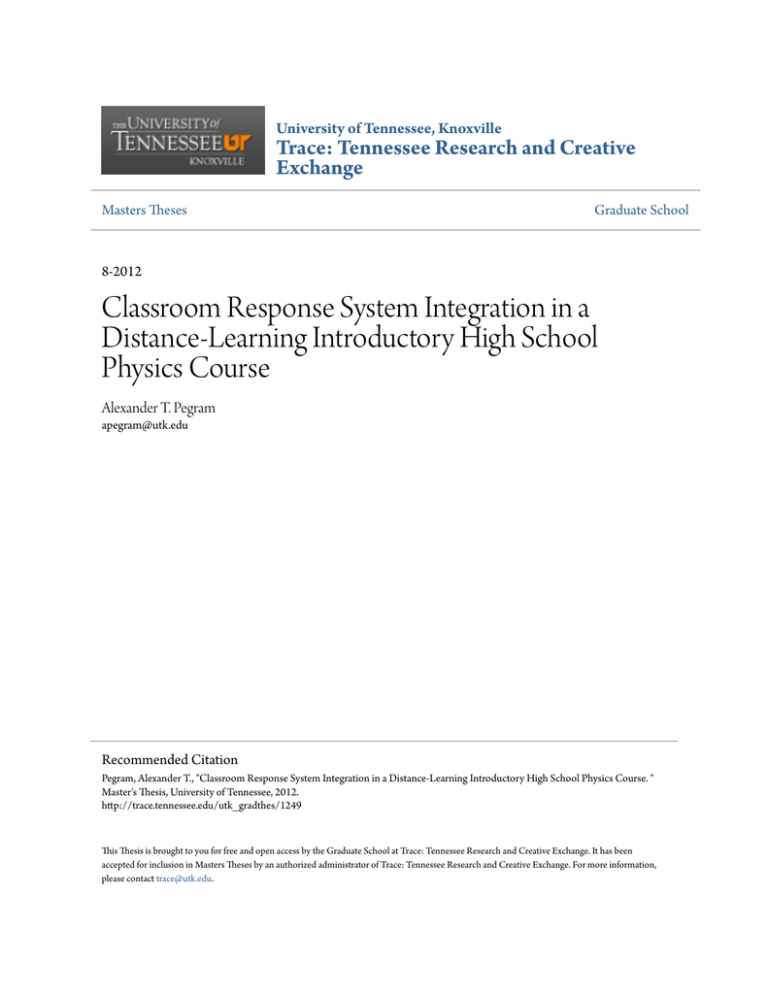
University of Tennessee, Knoxville
Trace: Tennessee Research and Creative
Exchange
Masters Theses
Graduate School
8-2012
Classroom Response System Integration in a
Distance-Learning Introductory High School
Physics Course
Alexander T. Pegram
apegram@utk.edu
Recommended Citation
Pegram, Alexander T., "Classroom Response System Integration in a Distance-Learning Introductory High School Physics Course. "
Master's Thesis, University of Tennessee, 2012.
http://trace.tennessee.edu/utk_gradthes/1249
This Thesis is brought to you for free and open access by the Graduate School at Trace: Tennessee Research and Creative Exchange. It has been
accepted for inclusion in Masters Theses by an authorized administrator of Trace: Tennessee Research and Creative Exchange. For more information,
please contact trace@utk.edu.
To the Graduate Council:
I am submitting herewith a thesis written by Alexander T. Pegram entitled "Classroom Response System
Integration in a Distance-Learning Introductory High School Physics Course." I have examined the final
electronic copy of this thesis for form and content and recommend that it be accepted in partial
fulfillment of the requirements for the degree of Master of Science, with a major in Physics.
Jon C. Levin, Major Professor
We have read this thesis and recommend its acceptance:
Marianne Breinig, Stuart B. Elston
Accepted for the Council:
Dixie L. Thompson
Vice Provost and Dean of the Graduate School
(Original signatures are on file with official student records.)
Classroom Response System Integration in a
Distance-Learning Introductory High School Physics
Course
A Thesis Presented for the
Master of Science
Degree
The University of Tennessee, Knoxville
Alexander T. Pegram
August 2012
Copyright © 2012 by Alexander T. Pegram
All rights reserved.
ii
ABSTRACT
Tennessee ranks among the lowest states in terms of high school physics
availability. This fact is compounded in rural areas by limited enrollment and a
lack of accredited physics teachers. A distance-learning physics course was
established between the University of Tennessee Knoxville and Morristown West
High School in order to offer an introductory physics course in a school with no
accredited physics teacher. Because classroom response systems have been
shown to increase interactivity and discussion in physics courses, leading to
better learning gains, the course was taught via live video-conferencing with the
integration of a classroom response system.
iii
TABLE OF CONTENTS
CHAPTER I Introduction and General Information .......................................................... 1
CHAPTER II Motivation ................................................................................................... 2
Physics Availability ........................................................................................................ 2
Participation and Interactivity ......................................................................................... 3
CHAPTER III Methods and Materials ............................................................................... 4
Instructional Method ....................................................................................................... 4
Monday: Review and Concept Introduction .............................................................. 4
Tuesday: Concept Review .......................................................................................... 5
Wednesday: Problem Solving .................................................................................... 5
Thursday: Online Lab Activity ................................................................................... 6
Friday: Problem Solving and Review with Mr. Hutchins.......................................... 6
Classroom Response System .......................................................................................... 7
Specific Setup Notes ....................................................................................................... 9
CHAPTER IV Results and Discussion ............................................................................ 10
CHAPTER V Considerations and Conclusions ............................................................... 12
Considerations............................................................................................................... 12
Conclusions ................................................................................................................... 13
LIST OF REFERENCES .................................................................................................. 14
Vita.................................................................................................................................... 16
iv
LIST OF FIGURES
Figure 1. High School Physics availability by state versus Expected Availability. . 2
Figure 2. Normalized learning gains of traditional (white bars) and enhanced
interactivity (black bars) physics courses. ............................................................ 3
Figure 3. Example conceptual question with example response rates. .................. 7
Figure 4. Example problem question with example response rates. ....................... 8
Figure 5. A comparison of raw score incidences between high school post-test
and university pre-test results. ............................................................................. 10
Figure 6. A comparison of normalized raw score incidences between high school
post-test and university pre-test results. ............................................................. 11
v
LIST OF ATTACHMENTS
Attachment 1. Monday Lecture Notes.... Chapter-8-Lecture-Notes.pdf
Attachment 2. Tuesday PowerPoint ……………Chapter-8-Torque.ppt
Attachment 3. Wednesday PowerPoint …………………………………
………………………………………….Chapter-8-TorqueContinued.ppt
Attachment 4. Thursday Activity…….. Activity11-TorqueAndInertia.doc
Attachment 5. Notes, Powerpoints, and Activity Sheets….... …………...
……………………………………………Notes-PowerPoints-Activities.zip
vi
CHAPTER I
INTRODUCTION AND GENERAL INFORMATION
A physics course was designed to allow a graduate student at the
University of Tennessee Knoxville and a teacher at a rural high school to
cooperatively teach a class of high school students. The course was taught
primarily through remote instruction via a live two-way video stream, with the
graduate student teaching from a classroom on the Knoxville campus to the
students in a high school classroom in the rural county.
Under the guidance of physics professor Dr. Jon Levin, I worked with a
high school teacher, Erik Hutchins, from Morristown West High School in
Hamblen County, Tennessee. Mr. Hutchins is a certified physical science
teacher who was interested in attaining accreditation in physics. As a result, one
goal of this project was to provide a means for Mr. Hutchins to gain a familiarity
with the conceptual understanding and problem solving skills necessary to obtain
physics accreditation.
The course was taught during the Fall semester of 2011. This coincided
with the high school’s block scheduling. As requested by the school, the material
taught in this semester focused on mechanics.
The class was taught by utilizing a variety of instructional methods, with
traditional style lectures being delivered via teleconference and web-based lab
activities being provided to further explore the concepts being discussed. Mr.
Hutchins was responsible for homework and exams which were primarily
assigned and graded via WebAssign. One goal of the project was to also
implement and test a Classroom Response System over a long-distance learning
environment.
1
CHAPTER II
MOTIVATION
Physics Availability
A study conducted by the American Institute of Physics in 2008-2009
compared the availability of high school physics courses among states. In the
results shown in Figure 1 (source: White, et. al), based upon enrollment factors
and proportions of seniors attending public schools, Tennessee was ranked
among the lowest states for physics availability. Compounding this fact is
evidence that seniors attending small public schools with small senior student
populations tend to offer physics less often than the larger, more populated
schools.
Figure 1. High School Physics availability by state versus Expected Availability.
In connecting with high schools with low physics availability, such as
Morristown West High School, one of the goals of this research was to implement
2
a distance-learning physics course in a school where no accredited physics
teacher was employed.
Participation and Interactivity
Research suggests that increased classroom participation yields better
learning outcomes. Classroom participation includes student discussion and
peer instruction. Figure 2 (source: Hake) shows an increase in the normalized
learning gains for students enrolled in physics courses with an emphasis on
enhanced participation. It has also been shown that peer and group discussions
are increased in classroom settings which implement a Classroom Response
System (CRS). Additionally, students in CRS classrooms are more likely to
respond to other students’ comments when compared to a non-CRS setting
(Fies, p. 101). As a result, another goal of this research was to successfully
implement a Classroom Response System in conjunction with the distancelearning structure in order to increase participation and enhance potential
outcomes.
Figure 2. Normalized learning gains, <g>, of traditional (white bars) and
enhanced interactivity (black bars) physics courses.
3
CHAPTER III
METHODS AND MATERIALS
Instructional Method
The textbook supplied by the school was Physics: Principles with
Applications, 6/E by Douglas C. Giancoli. Although this text often references and
utilizes calculus techniques in its derivations, the course itself was intended to be
an introductory, algebra-based course. Because the school already had copies
of this text, it was impossible to select another text for the purposes of this
course. However, understanding and efficiency with calculus was not required
for most of the homework problems available in the text, and many of the
concepts could be introduced without relying on calculus concepts.
When the university semester started, the high school’s classes had already
been in session for two weeks. During that time, Mr. Hutchins began teaching
the first two chapters of material to the students. These chapters primarily
involved understanding of the scientific method, material with which Mr. Hutchins
was already familiar teaching in his physical science courses. As a result, the
initial lessons taught via long-distance learning were primarily a review and
discussion of basic vector properties. Following this initial review, each new
lesson followed a similar weekly structure. The following is a typical weekly plan.
Monday: Review and Concept Introduction
Mondays began with a quick review of the previous week’s concepts along
with help on any particularly troubling homework problems and questions. After
addressing any questions or concerns that might have arisen from the previous
week’s lab and/or problem solving review, I would begin to introduce the new
material. This lesson was mostly taught by traditional lecture (see: Attachment 1:
Chapter-8-Lecture-Notes.pdf).
On these days, pertinent derivations would be shown and new variables
and equations would be introduced. This lesson would usually be conveyed via
white-board notes while the students took notes from the video-feed. In order to
solidify the concepts, physics demonstrations from the physics department’s
supply would be shown and discussed when applicable. However, set up and
execution of the demonstrations were dependent on the video camera’s ability to
move and focus at various angles. It was beneficial in many cases to have a
table in view of the camera on which to place demonstration materials.
4
Tuesday: Concept Review
Having introduced the new material on the previous day, Tuesdays would
begin with questions relating to the previous day’s material. Questions asked on
these days were typically conceptual, often coming from the “Questions” section
at the end of the textbook chapter preceding the “Problems” section. These
questions rely less on mathematical understanding and more on the application
of physical laws.
The questions, if open ended, were given to the students to discuss in
small groups. The seating arrangement of the high school classroom naturally
divided the students into 3 separate groups. Having been posed a question, the
students would be given approximately 2-5 minutes of wait-time in order to
discuss the question. If the questions were multiple choice, they were utilized in
conjunction with the Classroom Response System (see Attachment 2: Chapter8-Torque.ppt). Due to the quicker response resulting from the CRS, less time
was spent waiting for answers. Once the correct answer was revealed, students
who correctly answered were then encouraged to discuss their reasoning to the
class, while students who responded with incorrect answers were encouraged to
ask questions in order to clarify their understanding. As a result, less time was
spent discussing concepts that the students were more comfortable with, freeing
up more time for discussing the more difficult concepts.
Aside from conceptual questions, relatively simple problems were also
presented in order to help familiarize the students with the new variables,
equations, and units. Many of these simpler problems came from the textbook’s
“Problems” section. The classroom response system was implemented in a
manner similar to the conceptual questioning described above, with similar
emphasis placed on student discussion and clarification.
Wednesday: Problem Solving
Having introduced and used the new concepts and equations,
Wednesdays were spent applying the new concepts and equations in the context
of real physics problems. Using a combination of PowerPoint presentation and
white-board notes, I would begin the day by solving one or two example
problems and highlighting key points of the problem solving process. Following
examples, both conceptual questions and simpler problems would be given to
the class as a whole while the students answered via the Classroom Response
System (see Attachment 3: Chapter-8-TorqueContinued.ppt). Due to the simple
nature of these earlier problems, the students were given a short time to
deliberate and discuss before responding. Again, students who submitted
correct answers would be encouraged to explain their reasoning while students
5
who answered incorrectly would be encouraged to ask questions to their
classmates or myself.
After this, the students were assigned selected problems to solve together
in groups. The students, divided in their 3 groups, would be given approximately
15 to 20 minutes to work together on separate problems selected from the text.
These problems were often similar to problems they would be assigned for
homework on WebAssign and were moderate in difficulty. After the groups had
solved their problem, or made their best effort, we would present and work
through each problem as an entire class, with each group leading the discussion
about their respective problem. The students would direct me as to what to write
on the white-board while explaining their thought processes and reasoning to the
other groups. This process was ideally repeated for each group if time permitted.
In the event that the all 3 problems were sufficiently discussed, CRS problems
would be presented to the class as a whole for extra practice before the end of
class.
Thursday: Online Lab Activity
Rather than connecting with the high school, I would send an online lab
activity and worksheet via e-mail to Mr. Hutchins for Thursdays. The class had
access to a computer lab once a week, and, instead of teleconferencing with me,
the students would meet with Mr. Hutchins in the high school’s computer lab.
In the online activities, the students would be given a web address to
various Flash- or Java-based physics simulations (see Attachment 4: Activity11TorqueAndInertia.doc). The students would then have an accompanying
worksheet that would be used to guide the students to explore and apply the new
concepts. Mr. Hutchins would supervise and be expected to assist the students
if necessary, allowing him an opportunity to teach the material.
While rare, there were a few occasions wherein my schedule allowed for
me to visit the school on Thursdays. On these occasions, I would bring
demonstrations to perform in the classroom that I felt did not translate well
through video, such as the angular momentum demonstrations which allow the
students to actively participate in the demonstration. Classroom visits were also
beneficial in helping the students and I overcome the detached feeling
associated with long-distance learning.
Friday: Problem Solving and Review with Mr. Hutchins
Fridays were left for Mr. Hutchins to plan. According to Mr. Hutchins, most
of these days were spent practicing problem solving techniques and overcoming
troubles in the homework assignments. These open-ended days allowed for Mr.
Hutchins to work on his own physics problem solving and physics instruction
6
skills. Any particularly difficult or unclear questions would be saved until the
following Monday and addressed in the week’s initial review.
Classroom Response System
The lectures and presentations also relied on the aforementioned
Classroom Response System, or “clickers,” by Turning Technologies. This
system, fully integrated into the PowerPoint presentations, allowed for real-time
feedback by measuring students responses to questions proposed in the
presentation. Again, due to network restrictions, it was required that the clicker
remotes and all necessary technology be present on the high school’s end.
The Classroom Response System yielded many benefits. Being able to
gauge in real-time the class understanding of course material made it easier for
me to focus on specific problem areas throughout the lesson. The clickers
enabled us to view the conceptual questions as a group while still allowing the
students to answer independently (See Figures 3, 4). However, in the longdistance learning scenario, the clickers yielded another benefit.
Figure 3. Example conceptual question with example response rates.
7
Figure 4. Example problem question with example response rates.
Early in the semester, before full clicker integration, it was often difficult to
get students to volunteer answers to questions. As is typically the case in many
classrooms, shyness and uncertainty often prevent students from answering
questions. This problem was exacerbated by the long-distance learning setup,
wherein the students also had to struggle with the unfamiliar scenario of talking
to a person on a television screen. The clickers remedied this problem by
allowing the students to silently submit answers which, in turn, allowed clearer,
quicker responses to proposed questions or problems.
After all students had submitted their answers and the correct answer was
revealed, students were then more willing to discuss their answers. Students
who submitted correct answers now had confidence to explain their thought
processes in front of other students, and students who submitted incorrect
answers were given an opportunity to ask questions to help clarify
misunderstandings. As a result, the clickers helped the students to gain a
familiarity with open, group discussion in the classroom and through the video
feed. The open discussion increased student involvement and interactivity and
8
provided insight into students’ understanding or misconceptions, allowing me the
chance to immediately target problematic concepts while relying on the already
established strengths of the students.
Specific Setup Notes
The traditional lecture methods implemented in the first days of each week
were performed with a combination of white-board notes and PowerPoint
presentations. I was able to control the video camera’s ability to pan and zoom,
allowing me to write on the white-board comfortably without sacrificing legibility.
Due to the restrictions of the school’s network security, I was unable to directly
control PowerPoint presentations via remote desktop as initially intended.
Instead, the presentations were e-mailed in advance to Mr. Hutchins, and he
controlled the progress of the presentation on the high school’s end. While not
necessarily ideal, this setup had the unintended consequence of giving the
classroom teacher a slightly more engaged role on the days involving lectures.
In the university room that I taught from, the camera and screen faced the
white-board, allowing me to face the camera while also viewing the high school
classroom on screen. In the high school classroom, two televisions were present
on two adjacent walls displaying the video-feed from the university, however only
one camera above one of the televisions was used to view the classroom.
Opposite the classroom camera, and thus visible to me, was a projector and
projector screen that displayed the PowerPoint presentations. In order for me to
see the current slide displayed, the presentations were made with dark
backgrounds and bright text so as to appear more legibly on my end of the
connection.
9
CHAPTER IV
RESULTS AND DISCUSSION
At the conclusion of the semester, the students were given a multiple
choice Force and Motion Diagnostic Survey consisting of conceptual questions.
This survey is often used to gauge student understanding. Because the high
school students were not given a pre-class survey, the results are compared with
pre-class results of a university, non-calculus based course at the University of
Tennessee-Knoxville in Figure 5.
Figure 5. A comparison of raw score incidences between high school post-test
and university pre-test results.
The high school sample was obtained from a class of 15 students as
compared to the university sample of 44 students. As a result, the overall
number of score incidences was higher for the university sample. To better
compare the diagnostic survey results, the scores were normalized by dividing
each incidence by the total number of students (See: Figure 6).
10
Figure 6. A comparison of normalized raw score incidences between high school
post-test and university pre-test results.
In the post-class survey, the high school students correctly answered an
average of 14.13 questions correctly out of a possible 30. This is higher than the
average of 11.22 correct answers for the pre-class survey of the university
students.
In comparing the scores, it is possible to assume that the students
involved in this distance-learning course will be equally or better prepared for a
university physics course than the students sampled by the university pre-class
survey.
11
CHAPTER V
CONSIDERATIONS AND CONCLUSIONS
Considerations
When attempting a distance-learning physics course, there are a few
considerations to take into account. One potential problem is ensuring teacher
involvement on the high school end, as the ultimate goal of the high school
teacher in such a course is to achieve accreditation. In order to increase his
involvement, Mr. Hutchins was given the responsibility of assigning and grading
homework and tests. This responsibility requires the teacher to follow the
progress of students throughout the semester so as to adequately create
assignments related to the material being covered. Due to the nature of the text
being used in this course, not all homework problems were well suited for an
introductory, algebra based course, and as a result, they must be assigned with
discretion.
Another avenue of increasing teacher involvement in the lectures was by
having the teacher control the PowerPoint and CRS presentations. While
involvement in such a scenario is minimal, it increases teacher participation by
ensuring that the teacher follows along with the lecture and is exposed to clicker
questions and student comprehension.
Other important concerns arise when considering the technological
requirements of such a distance-learning course. While Morristown West High
School did not have dedicated physics facilities, they did have facilities and
funding dedicated to the installation and implementation of technology required
for a distance-learning course. If another high school were to implement such a
course, it would be necessary for the school to have access to the high-speed
internet and hardware required for smooth, clear video-conferencing, or for the
participating university to be able to supply such technology.
Similarly, when establishing such a course, the high school’s class
schedule must be considered. MWHS’s block scheduling was beneficial in
accommodating the university’s semester schedule. For high schools not on the
block schedule, it is possible that the participating graduate student might be
required to commit to teaching for 2 semesters, or one high school year.
Within the semester, there were also difficulties, albeit few, in weekly scheduling.
It is not unlikely for a high school’s spring or fall breaks to not coincide with the
university’s breaks. In this case, the university’s breaks fell mostly on the days in
which I would not normally be planning to teach directly to the students. As a
result, there was no disruption as the students continued with the planned webactivities or problem solving reviews with their high school teacher.
12
Conclusions
In reviewing the semester and course, it is apparent that a high school
physics course taught via distance-learning can be successfully implemented
with a Classroom Response System. Although the results of the high school
post-survey were not exceedingly more positive than those of the university presurvey, the high school students benefitted from the availability of physics
instruction, and those who continue onto college will likely be better prepared for
university level physics courses. The implementation of the Classroom
Response System also proved successful as the students showed an increased
willingness to participate in class and group discussions despite the disconnect
created by the distance-learning set up. The experience provided by the course
as a whole will certainly better prepare the students for future endeavors, as the
technological familiarity, encouraged participation and interactivity, and exposure
to physical concepts become increasingly important in higher levels of education.
13
LIST OF REFERENCES
14
White, Susan and Casey Langer Tesfaye. “High School Physics Availability:
Results from the 2008-09 Nationwide Survey of High School Physics
Teachers” (2010). Retrieved from:
http://www.aip.org/statistics/trends/reports/hstphysicsavailability.pdf
Hake, Richard. “Interactive-engagement versus traditional methods: A sixthousand-student survey of mechanics test data for introductory physics
courses.” Am. J. Phys. 66, (64-74) 1998.
Giancoli, Douglas C. Physics: Principles with Applications. Sixth edition. Pearson
Prentice Hall. Upper Saddle River, New Jersey. 2005.
15
VITA
Alexander Taylor Pegram was born in Murfreesboro, TN, to the parents of
Walter and Jennifer Pegram. He is the younger brother of Dr. Trey Pegram. He
attended Reeves-Rogers Elementary and continued to Central Middle School
and Oakland High School in Murfreesboro, TN. After graduating high school, he
attended Middle Tennessee State University to study physics. Having numerous
opportunities to practice teaching, lecturing, and tutoring at the university, he
developed an interest in physics education. In August of 2010, he graduated
from Middle Tennessee State University with a Bachelor’s of Science degree in
Physics. Afterwards, he accepted a graduate teaching assistantship at the
University of Tennessee, Knoxville, in the Physics and Astronomy department.
Alexander graduated in August 2012 with a Master’s of Science degree in
Physics. He is continuing to educate and learn in Japan with the Japanese
Exchange and Teaching Program.
16

